
Original Link: https://www.anandtech.com/show/2592
There have been numerous product sessions at IDF this week, some sexy, some interesting, and some about as exciting as watching Uncle Burt fall asleep in the recliner. Certain technical sessions on subjects like i7/X58 had long lines of people waiting anxiously to see and learn about the "It" product at IDF 2008, while other sessions on Intel's new SSD, Larrabee, and CE3100 SoC products generated a great amount of interest and attendance.
While those sessions were interesting. exciting to some degree, and even thought provoking at times, we noticed one particular session on the calendar that became center point on our radar screen. It had a very bland title that could easily be overlooked, "Enhancing the Media Experience with Intel Integrated Graphics", but we knew it really meant a G45 overview or so we hoped. Turns out, we were almost right on the money.
We wanted to understand more about this media experience enhancement offering, but most of all we wanted to get some answers about Intel's latest IG chipset. You know, the chipset that was late to market, promised a change in how we would view/experience high definition content, offer a superior gaming experience compared to previous IG solutions, and generally solve world hunger problems. We knew most of these attributes were marketing speak, but we have been very excited about Intel's first IG solution that offers hardware accelerated playback of high-definition content.
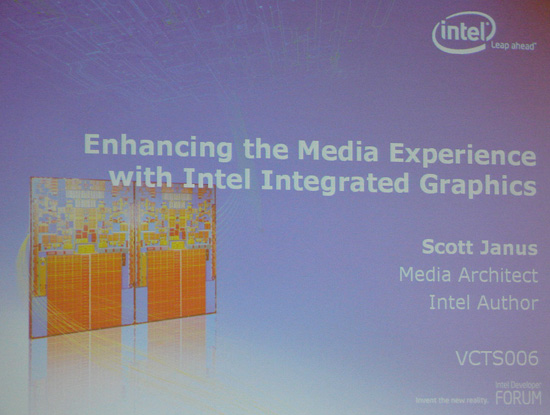
Why might one ask is an IG chipset so interesting to an editorial group that tends to be on the bleeding edge when it comes to hardware choices? Well, most of us are HTPC users and chipsets that offer accelerated high-definition playback, multi-channel LPCM output over HDMI, and a low-power envelope sounds just as sexy to us as the upcoming X58 chipset. However, our primary reason is that we wanted face time with the personnel responsible for the G45/GS45/GM45 series of products.
You see, the last three weeks have been extremely frustrating for us after receiving our sample G45 motherboards. We will not dwell on all of our problems as that conversation is saved for the chipset launch article. Suffice it to say, we have encountered every problem ranging from 1080P/24Hz support, lack of receiver repeater capabilities, compatibility problems with BD software playback programs, and the list just goes on. After numerous phone calls, emails, and meetings with Intel support personnel over the past few weeks, we finally had the opportunity to meet them in person.
We had our knives sharpened and ready as we wanted answers or there was going to be a fight. But before we could discuss and address our problems, there was this matter of sitting through a presentation. One that we just wanted to skip through so we could get some answers. Turns out the presentation answered several of our more pressing questions but left just as many unanswered at this point.
So without further delay, here is a recap of the presentation and some commentary about where Inel is at with the G45 product.
Scott Janus lead the technical session today. He is the Media Architect for Intel, an accomplised author, and has been around since the i740 graphics product about a decade ago.
Performance-

The conference started out with an overview of why the personal computer is becoming an important tool for watching video. A theme that carried over from the keynote speeches this morning. In fact, the latest studies show the average user watches 228 minutes of video over the internet each month. Also, just in the US, we viewed over 12 billion videos online in May of this year alone. Besides watching videos online, viewing high definition content is becoming increasingly important.
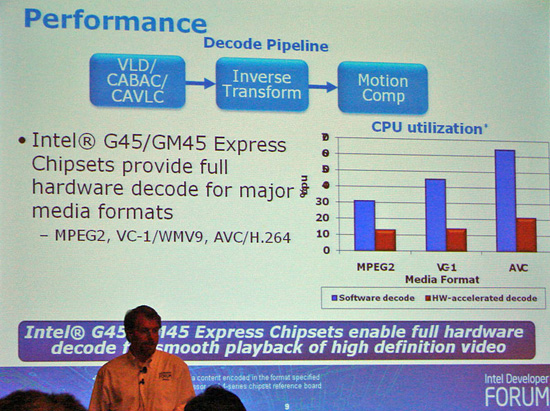
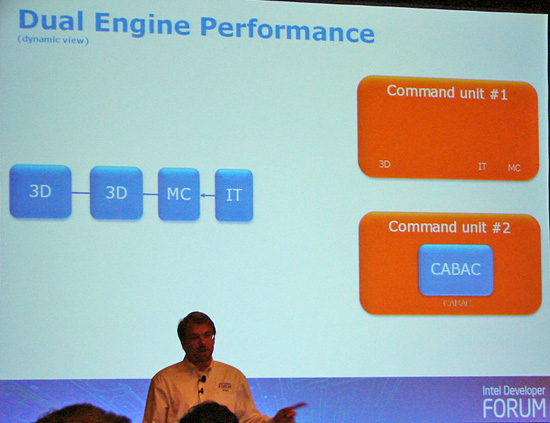
The session started to get interesting as Scott delved into some of the unique performance features of the G45 family. Unlike previous Intel chipsets, the G45 series offers full hardware decode capabilities for MPEG2, VC-1/WMV9, and now AVC/H.264. CPU utilization rates are down significantly now with H.264 dropping down around 20% compared to 75% in our testing, results similar to Intel.
One of the performance enhancements that Intel designed into the G45 is the Dual Engine layout (balanced parallel decode engines). This design is different from previous Intel chipsets as it features two Command units. The first command unit will complete 3D layer, motion compensation, and inverse transform tasks while the second command unit will work exclusively on CABAC (context-adaptive binary arithmetic coding) routines.
CABAC is one of the more popular video encoding algorithms due to superior compression techniques in AVC/H.264 encoding. CABAC routines require an extensive amount of processing power during the decode process compared to similar algorithms. As such, Intel determined one of the best ways to improve performance and reduce power is to send CABAC routines to a second command unit.
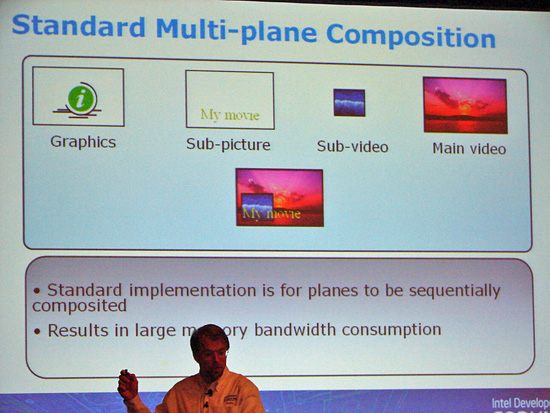
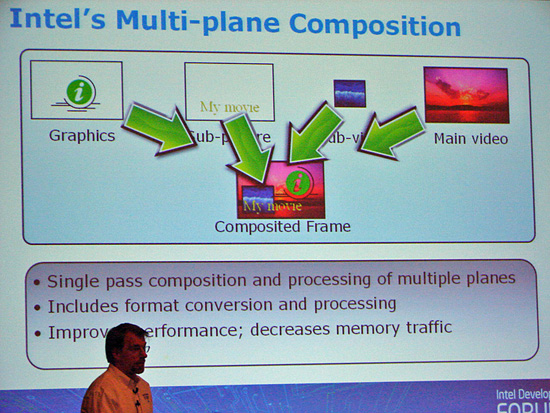
Another performance enhancing technique that Intel implemented is a Multi-plane composition routine that features single pass composition and processing of multiple planes along with format conversion and processing. Compared to the standard Multi-plane composition technique that requires the various planes to be sequentially composited, the new routine decreases memory bandwidth requirements significantly.
Power Efficiency-
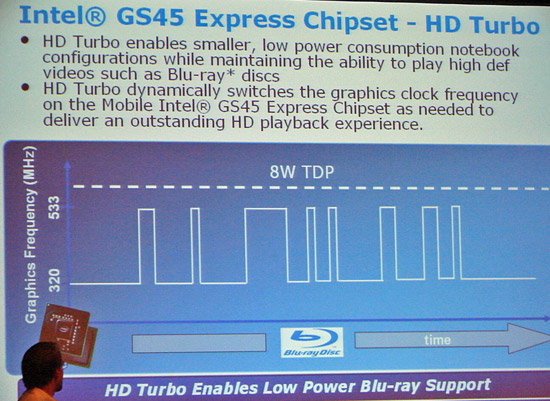
For the notebook crowd, Intel looked at various ways to reduce power during high-definition content playback. One of the features added to the GS45 mobile chipset is a function called HD Turbo. This feature dynamically switches the graphics core clock frequency as needed to ensure proper HD playback. The range allowed is anywhere from 320 MHz to 533 MHz. Also featured is version 4 of DPST (Display Power Saving Technology) that dynamically controls picture brightness by influencing backpanel lighting. All together, these new features allow the GS45 chipset to reach a 150 minute range when playing back a typical H.264 title compared to 104 minutes with the previos GM965 chipset utilizing a 58W per hour battery setup.
Did we get our questions answered?
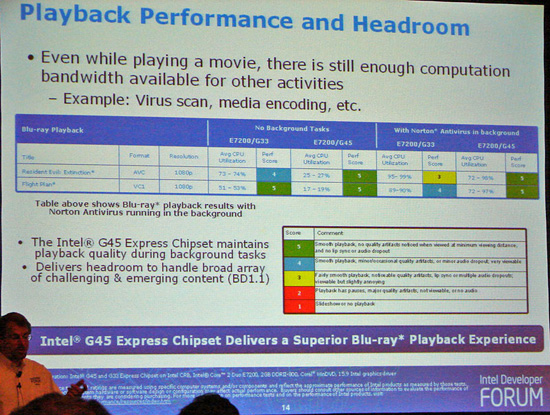
Intel made a point that the G45 is capable of playing back high-definition content while performing other tasks. To prove their point, they presented an interesting demo that featured the Blu-ray and SD versions of Batman Begins each playing at the same time along with Blu-ray picture-in-picture playback. Of course, we have had this capability from AMD and NVIDIA for several months but the G965/G35 could not handle this task. What really made the demo interesting was the video/audio output being sent to the Onkyo TX-SR605 and then out to the display and speakers via HDMI.
That's right, repeater mode is finally working. After a closer inspection of the display output, de-interlacing and post processing is now active. However, 1080P/24Hz playback support is still not working properly. Before getting too excited, this demo was presented with the new 15.11 drivers (newer than the 7/26 release) and a beta version of Corel WinDVD 9.0 Plus. The upgraded 15.11 driver set will be released this week, but we still do not have a firm release schedule from Corel, Cyberlink, or ArcSoft on patches to their BD capable products that feature full repeater and Intel Clear Video support.
Even though repeater mode is working correctly in the press demos, we are still not sure about full repeater support for the most popular receivers from Denon, Pioneer, Sony, or Yamaha as Intel has only tested this feature on models from Onkyo and Astro. Until we have proper software support, this platform will continue to be crippled for the serious HTPC user. That's a shame really as this chipset has tremendous potential for the HTPC market. Look for our G45 review shortly and hopefully we will have some good news regarding software updates by then.







